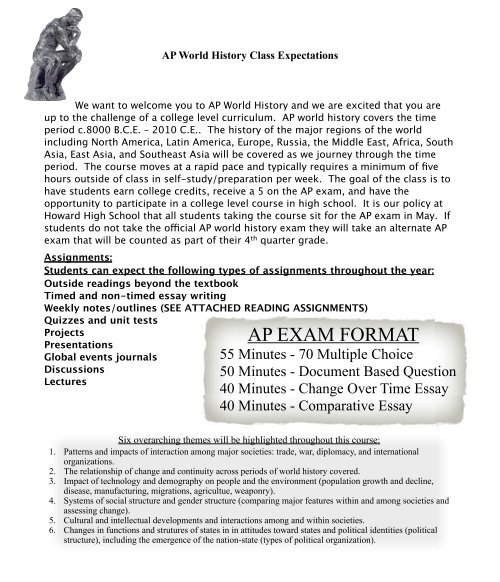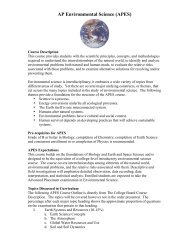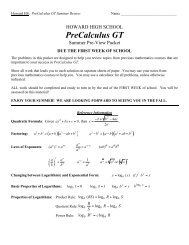AP World History Course Description - Howard High
AP World History Course Description - Howard High
AP World History Course Description - Howard High
You also want an ePaper? Increase the reach of your titles
YUMPU automatically turns print PDFs into web optimized ePapers that Google loves.
<strong>AP</strong> <strong>World</strong> <strong>History</strong> Class Expectations<br />
We want to welcome you to <strong>AP</strong> <strong>World</strong> <strong>History</strong> and we are excited that you are<br />
up to the challenge of a college level curriculum. <strong>AP</strong> world history covers the time<br />
period c.8000 B.C.E. – 2010 C.E.. The history of the major regions of the world<br />
including North America, Latin America, Europe, Russia, the Middle East, Africa, South<br />
Asia, East Asia, and Southeast Asia will be covered as we journey through the time<br />
period. The course moves at a rapid pace and typically requires a minimum of five<br />
hours outside of class in self-study/preparation per week. The goal of the class is to<br />
have students earn college credits, receive a 5 on the <strong>AP</strong> exam, and have the<br />
opportunity to participate in a college level course in high school. It is our policy at<br />
<strong>Howard</strong> <strong>High</strong> School that all students taking the course sit for the <strong>AP</strong> exam in May. If<br />
students do not take the official <strong>AP</strong> world history exam they will take an alternate <strong>AP</strong><br />
exam that will be counted as part of their 4 th quarter grade.<br />
Assignments:<br />
Students can expect the following types of assignments throughout the year:<br />
Outside readings beyond the textbook<br />
Timed and non-timed essay writing<br />
Weekly notes/outlines (SEE ATTACHED READING ASSIGNMENTS)<br />
Quizzes and unit tests<br />
Projects<br />
Presentations<br />
Global events journals<br />
Discussions<br />
Lectures<br />
<strong>AP</strong> EXAM FORMAT<br />
55 Minutes - 70 Multiple Choice<br />
50 Minutes - Document Based Question<br />
40 Minutes - Change Over Time Essay<br />
40 Minutes - Comparative Essay<br />
Six overarching themes will be highlighted throughout this course:<br />
1. Patterns and impacts of interaction among major societies: trade, war, diplomacy, and international<br />
organizations.<br />
2. The relationship of change and continuity across periods of world history covered.<br />
3. Impact of technology and demography on people and the environment (population growth and decline,<br />
disease, manufacturing, migrations, agricultue, weaponry).<br />
4. Systems of social structure and gender structure (comparing major features within and among societies and<br />
assessing change).<br />
5. Cultural and intellectual developments and interactions among and within societies.<br />
6. Changes in functions and strutures of states in in attitudes toward states and political identities (political<br />
structure), including the emergence of the nation-state (types of political organization).
Textbook Reading Schedule:<br />
This is a copy of the 2010 - 2011 reading schedule. Typically students will have<br />
one week to read and take notes on a chapter. The reading schedule acts as a<br />
good guide for the topics covered during the year.<br />
Textbook Chapters:<br />
Due:<br />
Chapter 1 From Human Prehistory to the early Civilizations 9/9<br />
Chapter 2 Classical Civilization in China 10/8<br />
Chapter 3 Classical Civilization in India 10/8<br />
Chapter 4<br />
Chapter 5<br />
Classical Civilization in Greece and Rome<br />
The Classical Period: Directions, Diversities<br />
10/8<br />
10/8<br />
and Declines 10/29<br />
Chapter 6 The Rise and Spread of Islam 10/29<br />
Chapter 7 The Spread of Islamic Civilization to South 10/29<br />
and Southeast Asia<br />
Chapter 8 African Civilizations: The Spread of Islam 10/29<br />
Chapter 9 Civilizations in Eastern Europe: Byzantium 11/23<br />
and Orthodox Europe<br />
Chapter 10 A New Civilization Emerges in Western Europe 11/23<br />
Chapter 11<br />
Chapter 12<br />
The Americas on the Eve of Invasion<br />
Reunion and Renaissance in Chinese Civilization<br />
11/23<br />
12/21<br />
Chapter 13 The Spread of Chinese Civilization 12/21<br />
Chapter 14 The Last Great Nomadic Challenges 12/21<br />
Chapter 15<br />
Chapter 16<br />
The West and the Changing <strong>World</strong> Balance<br />
The <strong>World</strong> Economy<br />
12/21<br />
1/14<br />
Chapter 17 The Transformation of the West 1/14<br />
Chapter 18 The Rise of Russia 1/14<br />
Chapter 19<br />
Chapter 20<br />
Early Latin America<br />
Africa in the Age of the Atlantic Slave Trade<br />
2/14<br />
2/14<br />
Chapter 21 The Muslim Empires 2/14<br />
Chapter 22 Asian Transitions in an Age of Global Change 2/14<br />
Chapter 23 The Emergence of Industrial Society 2/25<br />
Chapter 24<br />
Chapter 25<br />
Industrialization and Imperialism<br />
The Consolidation of Latin America<br />
2/25<br />
3/10<br />
Chapter 26 Civilizations in Crisis 3/10<br />
Chapter 27 Russia and Japan Industrialize 3/10<br />
Chapter 28 <strong>World</strong> War I 3/25<br />
Chapter 29 The <strong>World</strong> in the 1920’s 3/25<br />
Chapter 30 The Great Depression and the Authoritarian Responses 3/25<br />
Chapter 31 A Second Global Conflict 4/05<br />
Chapter 32 The Cold War 4/05<br />
Chapter 33 Revolution and Reaction in Latin America 4/15<br />
Chapter34 The Era of Independence 4/15<br />
Chapter 35 Nation Building in East Asia and the Pacific Rim 5/2<br />
Chapter 36 Globalization and Resistance 5/2





